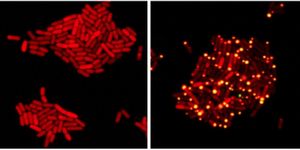A Dynamic DNA Origami Technique
It was not a while back ago when researchers developed a unique technique known as ‘DNA origami’ to produce tiles that could be self-assembled someday into larger nanostructures carrying predesigned patterns or ‘images’. However, their existed a limitation with that technique—once the image was made, it cannot be changed. Now, in a study published in Nature Communications, scientists at Caltech were ready to overcome this hurdle by developing new dynamic tile allowing for the re-shaping of already built DNA structures. The technique was tested on building smiley faces using DNA and even an old-fashioned game of tic-tac-toe.
An artist's rendering of a game of tic-tac-toe played with DNA tiles
Credit: CalTech via Science Daily
"We developed a mechanism to program the dynamic interactions between complex DNA nanostructures," says Lulu Qian, an assistant professor of bioengineering at CalTech who originally pioneered the technique now known as DNA origami. "Using this mechanism, we created the world's smallest game board for playing tic-tac-toe, where every move involves molecular self-reconfiguration for swapping in and out hundreds of DNA strands at once."
The new technology allows for displacement abilities in self-assembling tiles—it follows the most basic principles of strand displacement on the DNA level but at a larger scale between DNA origami structures. Such development can help researchers understand the behavior and dynamic interactions between different structures of DNA. Ultimately, the purpose of the research study is to use the technology for the development of nanomachines that can hold the capability of being modified or repaired even after being built.
Learn more:
"When you get a flat tire, you will likely just replace it instead of buying a new car. Such a manual repair is not possible for nanoscale machines," says Qian. "But with this tile displacement process we discovered, it becomes possible to replace and upgrade multiple parts of engineered nanoscale machines to make them more efficient and sophisticated."
Source: Nature Communications, CalTech, Science Daily










